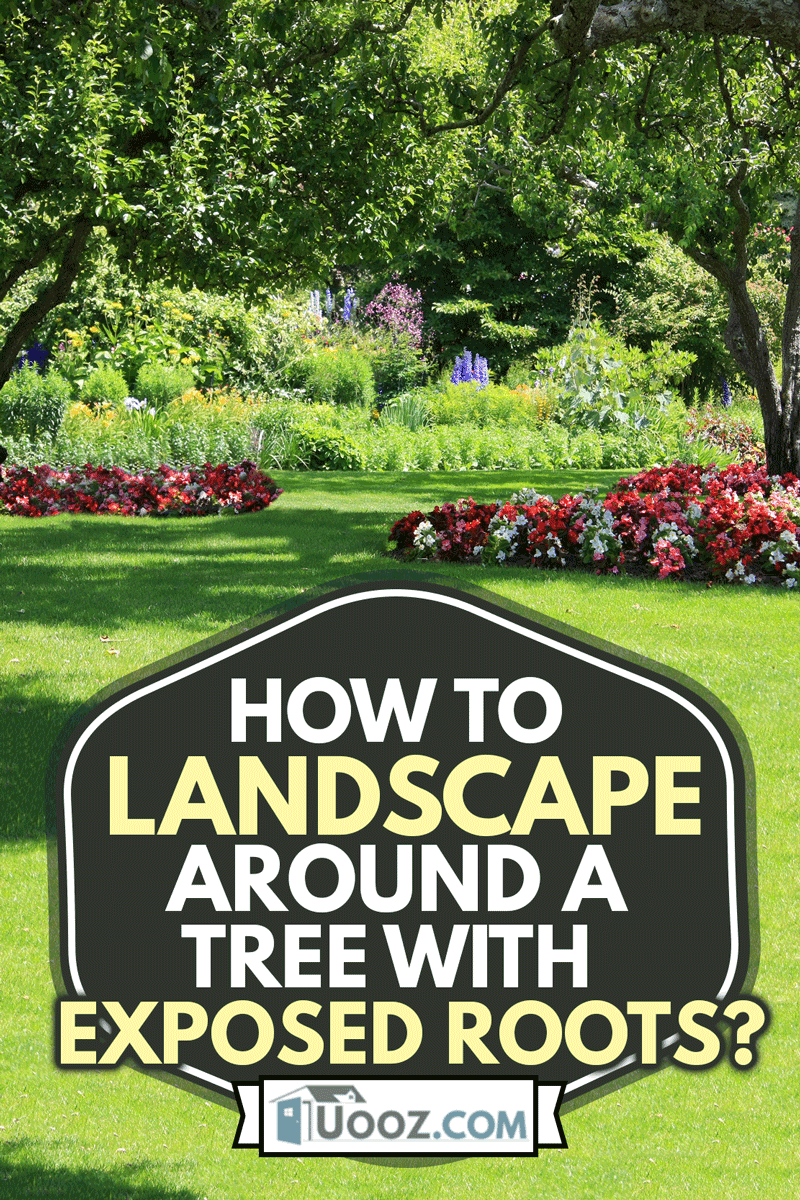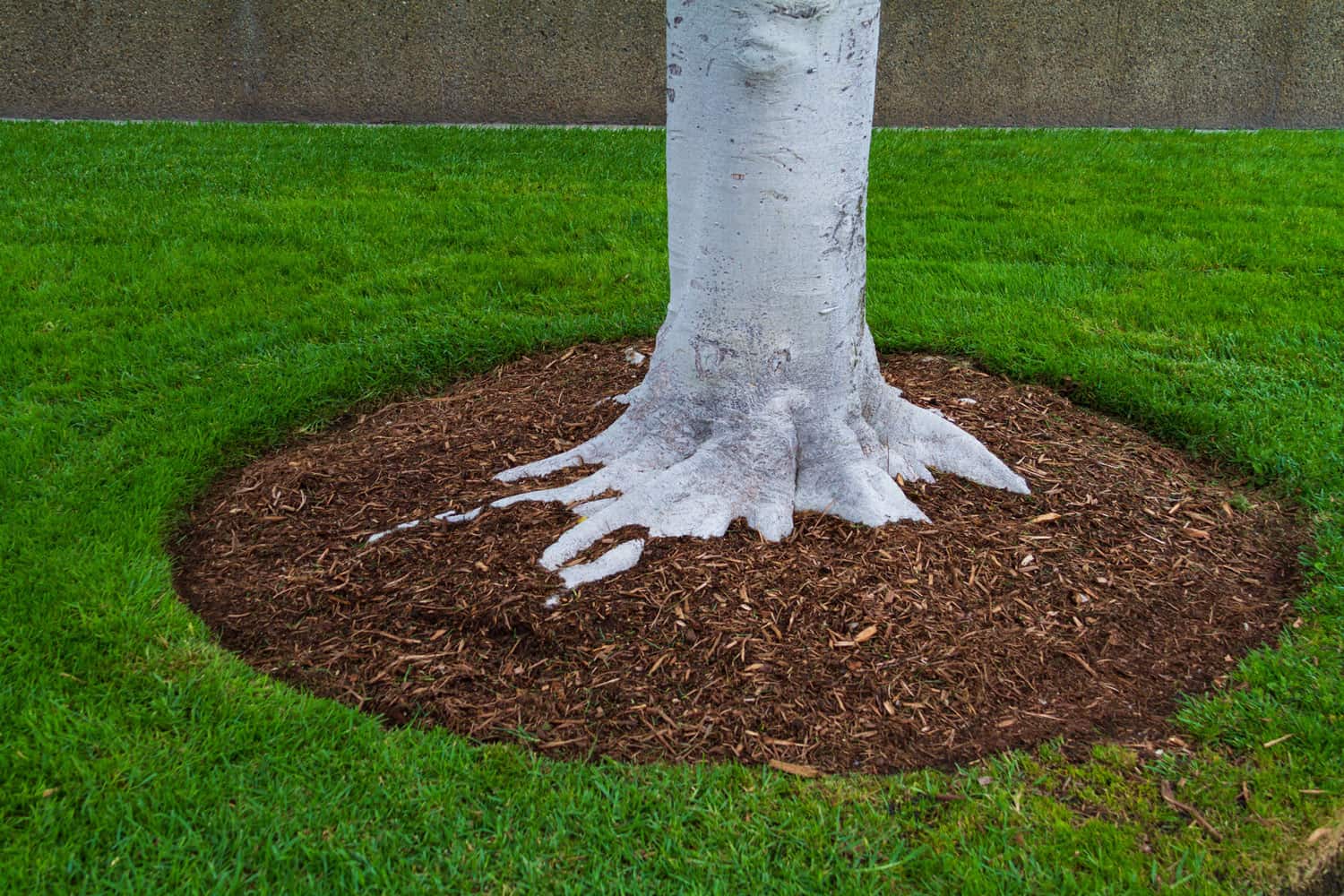Several different factors can cause exposed tree roots (or Girdling Roots). The most common are erosion due to climate or environment and lack of maintenance over the years as the tree has grown. Regardless of the reason, exposed tree roots can cause a decline in the tree's health. Remember that a tree is a living, breathing thing that receives its nutrients from the soil. We've done the homework for you on what to do with landscaping around exposed tree roots, so let's explore some landscaping options that will also aid in your tree's health.
For the health of your tree, landscaping should involve covering any exposed roots. Place an edging (border) around the tree's base. Then, fill the space between the edging and the tree's base with 3-5 inches of topsoil, potting soil, mulch, or stone to help stabilize your tree's health. Make sure your filler material is level and spread evenly. Too much material against the tree's base (volcano-shaped extending up the trunk) invites the chance of tree rot or disease. Here are some landscaping options to spark inspiration:
- Mulch
- Plants
- Stone
Let's have a more detailed look into those options to give you an example of how they would look and help you decide if any of those options are a good fit for your particular landscaping project.

Landscaping Around Exposed Tree Roots
Landscaping a tree with exposed roots is not as difficult as it may seem. Although you should definitely cover the root system, there are many lovely options from which to choose.
Mulch
Using Mulch is a great way to add a finished look to the area surrounding your tree.

Plants
Plants give a softer, polished look to landscaped trees. Consider plants that are shade friendly such as Hostas. Flowering plants such as Marigolds or shade friendly herbs are also worth your consideration.
Stone
There are beautiful options when considering stone. Different sizes and colors add appeal. Pea gravel or small smooth river stones help to keep the area virtually maintenance-free.
Should you cover exposed tree roots with dirt?
Dirt is a viable option. Exposed tree roots put your tree at risk for damage or death. A dead tree is never a good thing, especially considering the extremely hazardous conditions that it will cause! Tree roots need to be covered or buried in approximately 12-15 inches of material to ensure a healthy root system.
Tree Root Growth
Major tree anchoring roots will grow vertically, while surface roots (taproots) will grow horizontally. Together these two types of roots comprise the root ball. Taproots extend far beyond the tree trunk itself. They are designed to provide oxygen and nutrients to ensure the trees' health, growth, and stability.
The International Society of Arborists Rockey Mountain Chapter says that root systems can spread to several timestree's canopy width. Licensed arborists follow the general rule that the taproot system extends to 10+ feet beyond the longest tree branch's tip. Covering the root system will help to ensure your tree is getting what it needs to thrive.
Topsoil Options
One thing to remember with the soil you use is that your tree will absorb whatever is in the soil. Manufacturers have made great strides in tree care and maintenance by offering products designed to feed and protect your tree from insects and illness. Here are a few great examples of products that you can easily use to amend your soil:
MiracleGro Tree & Shrub Plant Food Spikes
BioAdvance Tree & Shrub Protect & Feed
Ortho Tree & Shrub Food Concentrate
Is it ok to put rocks around your tree?
Have you ever driven down a street and saw a perfectly manicured area with stone around trees with perfect borders? Have you wondered if that is good for a tree? The answer is both short and long. Yes, it is ok to put rocks or stone around trees but remember the taproot system. Taproots are not going to find any nutrients in stone.
Roots will work extra hard at seeking out what the tree needs beyond the stone tree bed. The root system will send out an even more complex system of those sucker taproots to find the nutrition and oxygen that the tree needs to survive. The easiest way to ensure that your tree is getting what it needs while using rocks or stone is to first lay a layer of level soil down for the root system, followed by a layer of stone around the tree's base.
There are many different things that you can use to mark out this tree bed, from professional edging to larger stone. Herbs, plants, container planters, or timbers can be incorporated. And let's not forget circular benches designed to surround the tree base where you can sit to enjoy the shade. All of those options can be used on a beautiful bed of stone.
Achla Designs Curved Bench
Are rocks better than mulch for landscaping?
Several factors are involved in deciding between rocks, mulch, or even dirt in your landscaping project. Rock adds far better drainage and is lower maintenance, but mulch holds moisture that your tree may need depending on your climate. Consider asking yourself these questions:
Species
What type of tree are you working with? Is it a finicky or hardy species? Is the tree native to the area or more ornamental, such as a flowering or fruit variety? Does it need a greater amount of moisture that mulch would provide, or would it thrive with additional drainage that stone would offer?
Climate
Is your climate moisture-rich, temperate or arid? Is the tree protected from direct wind currents, or is it part of a windbreak? Does the tree have full sun or filtered sun throughout the day?
Environment
Where is your tree planted? Is it located by itself or among a group planting? Can it get the adequate nutrients that it needs from the surrounding area?
Budget
What is your budget? This actually has a big impact on what you ultimately decide to do with your project. You'll need to do your homework on this aspect. Obviously, you can watch for special sales at home supply stores or garden centers. Sometimes local hardware stores, nursery's and grocery stores might have affordable offerings.
You may find it beneficial to contact a local rock quarry to find a cost-effective solution for a pickup truck load of stone. Could you share the cost and stone with a neighbor who is working on their own project? For mulch, consider contacting a local tree service. Inquire about the chip from one of their tree reombal jobs. More times than not, they'll have chipped remnants of a tree removal and will be more than happy to discuss delivery. Just let them know exactly what you are looking for, so they can help.
Final Thoughts
In the grand scheme of things, it might just all boil down to your personal preference and your imagination. Once you know what your tree will need to thrive, what do you want to see? On the one hand, you want to ensure the tree's health. On the other hand, you may want to cover those unsightly exposed roots and continue your landscaping vision across your property.
The bottom line is that an uncovered root system will be detrimental to your tree's health. There are very few species that can survive with any root ball exposure. It's not impossible, but conditions have to absolutely be perfect for that to happen. Also, contacting an ISA Certified Arborist might be your best bet. They have taken the necessary professional steps to qualify as an authority. They will certainly be a fantastic source of information.
For additional information on landscaping with different types of rock, check out the post: "10 Types of Landscaping Rocks You Should Know."
And for a fascinating look at landscaping timetables and how to efficiently plan your landscaping project, check out the post: "How Long Does Landscaping Typically Take?"




